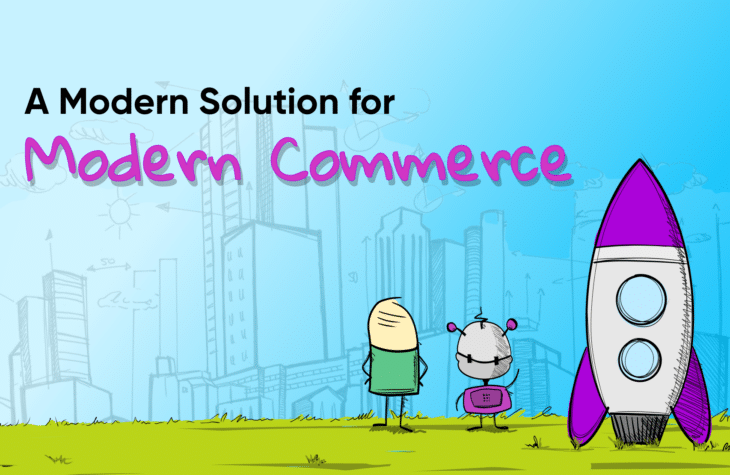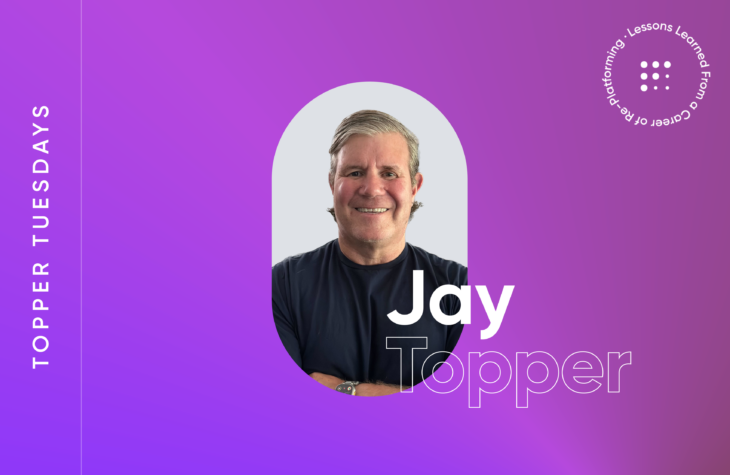Digital Publishers as Retailers with Ryan Bartley [Podcast]

In this episode of Coffee + Commerce, Ryan Bartley, our co-founder at Fabric talks about opportunities for digital publishers who want to infuse commerce into content to either complement or replace subscriptions and affiliate sales.
He discusses how digital publishers can leverage dropshipping to fulfill readers’ orders, which ultimately benefits both parties differently than the affiliate business model.
Listen to this episode on your favorite podcast player.
Questions asked and answered in this episode include:
- 1:10 What are some opportunities for content and commerce for digital publishers?
- 2:35 How can digital publications infuse content with commerce?
- 5:11 How do publishers and readers benefit by integrating commerce?
- 8:12 Is there an opportunity for community-based publishing platforms to infuse content with commerce?
- 9:19 How about adding commerce to video streaming and podcast platforms?
- 10:53 Will the commerce functionality take away from the user experience?
- 11:34 What kind of talent is needed to make content and commerce work?
What are some opportunities for content and commerce for digital publishers?
1:10 Robert Gibb
So what are some opportunities for content and commerce for digital publishers, and what can they learn from retailers today?
1:17 Ryan Bartley
Historically, retailers are good at merchandising, good at brand marketing, good at driving products to a location that’s convenient to customers. But what they’ve been really bad at is content and being an expert in content and being an expert in their domain.
Meanwhile, you flip the script, and you look at publishers who have over the last, I would say since the Internet’s been born, had a challenge with their business model. You’ve seen that with more paper-based publications that have had to move digital. And now the advertising model is even more constrained too. So frankly, they’re looking at an existential risk with their business model.
Meanwhile, they are the authorities of content, so they get eyeballs, they get mini content providers that talk about I’m shocked at the level of traffic that they get every month to their digital properties, and they’re just not monetizing it because of the business model problem. And so they have to evolve and figure out a new business model, simple as that.
What they lack is, and the important thing to realize is they’re experts, and people come to them for things like discovery, motivation, and understanding of a new domain. So they become authorities in that content, and that’s why people come and read them. But they haven’t connected with commerce. And so the opportunity in the next five years is for the publishers of the world to become the best retailers in the world.
How can digital publications infuse content with commerce?
2:35 Robert Gibb
Right, but how can digital publications infuse content with commerce? Do they have to incorporate some aspect of dropshipping? And how do they partner with retailers or these brands to actually get the products that they’re talking about to the users and shoppers and readers?
2:52 Ryan Bartley
That’s the beauty of software today, and all the components are there. So Fabric, obviously we have a modular e-commerce platform, which means that any workload or any type of commerce that you can imagine can be enabled with our components.
So what that means is if you think about what a publisher has invested in from a software perspective, they’ve invested in CMS, publisher Content Management System that runs their site through the journalist or the writer writes the article, publishes it through the CMS to the site.
All you have to do is add in the commerce capabilities to that as well. And it’s actually pretty simple, believe it or not. It’s few lines of JavaScript code for a developer where effectively what the developer needs to do, and the publisher is, start to expose parts of Fabric’s platform.
So the way it works is, imagine reading an article, and you want to put in a product, you add your JavaScript, it calls our PIM, Product Information Manager, where all the products live, and the product data lives, and then it gets pulled into that article. When a customer clicks on “buy” or “check out,” then they can expose our cart and check out capabilities right within that experience.
So literally it’s just a simple integration or a publisher to enable commerce of Fabric. The last part of that, and most important part is, OK, where are the products coming from? And you can’t expect the publisher to be a true retailer who has inventory and warehouses and all that stuff.
The beauty of Fabric is, we actually have a dropship capability, and that dropship capability, what allows a publisher or any company to do is have zero inventory risk and the ability to source effectively any product in the world. So all the distributors, wholesalers, manufacturers, like the people who actually build the products or house them in a warehouse, we connect to all of them, which means that you can come into the Fabric products, and you can simply choose which products you want to sell.
You never touch that inventory. They never get shipped to you. They sit in the locations with that manufacturer. And when that customer on your site taps pay for an order, we have an order management system that then routes that order back to that vendor and says, hey, come fulfill it, and it gets fulfilled from that location to the customer.
So long story short, a publisher can own zero inventory, have no inventory risk, and be able to sell a curated set of products that matter for their customers. It’s a pretty amazing concept, asset-light model.
How do publishers and readers benefit by integrating commerce?
5:11 Robert Gibb
Yeah. It seems better for them, and it seems better for the reader, because the reader no longer has to subscribe, because at some point it seems like the publisher could make more money by just integrating commerce. They wouldn’t have to rely on subscriptions.
5:26 Ryan Bartley
Yeah. I think from a publisher’s perspective they have to consider their business model. Do they believe that their content is important enough to stand on its own for somebody to pay for with the subscription? Yes or no? However, I don’t think that they need to make a hard choice between commerce and subscriptions. That can truly be an and instead of an or.
So imagine this. Today many publishers are dipping their toes in the water in commerce, and the way that they are doing it is doing an affiliate model. So this is really important to understand.
The affiliate model, the way it works is you write an article, and you have links to products. When a customer clicks on that product link, they get sent to the retailer’s website. You may go to Nordstrom or Amazon or some or some other retailer’s website. You finish your purchase and your transaction, right?
Well, if the customer makes a purchase, the publisher will get roughly 3 to 5 percent of the revenue for that order, because they send a customer to retail.
The challenge with that model is, number one, that’s a pretty low monetization. 3 to 5 percent of the product cost. And two, more importantly, the publisher doesn’t keep that customer’s data. They don’t know what the customer purchased. They don’t understand or have the order lifecycle. And so they can’t monetize, really, that data that they have to better inform their writing; to better inform their segmentation. And so long story short, they’re not making much money, and getting much value out of this affiliate model.
If they transition over to dropship direct commerce by simple integration with Fabric, then the financial picture and the value picture changes dramatically.
Number one, you keep customers on your site. You understand and have that customer identity and order history. And so you can better target your publishing all the way from top to bottom. What content am I my writing? Who am I focused on? So, you own the customer data that doesn’t flow out of your system into retail, and that is terribly important.
The second part is the difference between dropship and affiliate is that dropship margin looks like a retailer. So you’re capturing anywhere from 20 to 40 percent of that product margin on each product. So 3 to 5 percent, 20 to 40 percent. It’s kind of a no-brainer, because there is, frankly, no risk.
And last but not least, you’re solving for that customer experience. You’re reducing all that friction. Imagine a customer reading an article, clicking a link, and going off to some other site. That’s not good for you as a publisher, and that’s not good for the customer because they’re now wandering off in the world trying to figure out how do I add my credit card to another website, and how do I make a payment and all that stuff versus a customer who can go through and simply read an article tap of product.
On top of that, you get a simple checkout form where you can tap pay, it goes away, and you continue reading, so you never leave the site. It’s a win-win for both customer and publisher, and it’s, from my perspective, a no-brainer.
Is there an opportunity for community-based publishing platforms to infuse content with commerce?
8:12 Robert Gibb
Yeah. This makes me think of Medium.com, too, as a publisher with user-generated content. So Medium.com and other user-generated blog sites, adding commerce as a new feature instead of just relying on subscriptions can be an and option, too, not just an or option. So it opens up a lot of opportunities for users of user-generated sites like Medium as well as publishers that have a more organized process.
8:40 Ryan Bartley
Yeah. Those platforms like Medium should be partnering with Fabric to enable these for their customers. So we become a platform of platforms, and Medium just effectively opens up their commerce capabilities, and that, you know, we talked about large publishers and large journalism rooms.
But there’s no reason why you can’t give that to the small and niche publishers as well, meaning a person who’s writing on Medium, and they have expertise, and they have a following, and likely they’re talking about physical products or digital products. There’s no reason why that person shouldn’t be monetizing that as well. And so it can be like you said, an and subscription and commerce revenue.
How about adding commerce to video streaming and podcast platforms?
9:19 Robert Gibb
Yeah. Affiliate links and advertising are just annoying to me at this point. So I’m betting commerce and experiences add a lot more value. Like the first thing I think of is Spotify. So instead of listening to advertisements at the beginning of a podcast, you have potentially a push notification that arrives on your phone when a specific product is being talked about. And then you can just tap that and order the product if you’re interested.
And then there’s also some opportunities with streaming platforms like Netflix. We talked about this with Faisal, our CEO and then Tim Guleri, our investor from Sierra Ventures, where you can buy something off of Brad Pitt’s back if you want to like a little clothing or a little item, whatever it is.
You have any thoughts on this like podcasts and then videos and these experiences?
10:07 Ryan Bartley
Yeah. I mean, the world is moving to video from a content perspective, obviously, and I think those platforms as well, certainly commerce, can be an and. And these are things that have been talked about, I don’t know since the beginning of e-commerce, since I’ve been around the late 90s, and now shopping on your TV. And what’s neat about it now is that we actually have all of the capabilities to do it.
There is no reason technically or infrastructure-wise that, that cannot be enabled. It’s really up to those content companies, like Netflix, just to focus on this as a new domain or new area. So I would personally love it. And I know if you go down and walk down the street and ask ten people would you like to buy something while you’re watching a Netflix show, I’m sure they’ll say yes. So it’s really up to them to figure it out.
Will the commerce functionality take away from user experience?
10:53 Robert Gibb
Yeah. As long as it doesn’t take away from the experience like it’s an option to have that commerce functionality.
11:00 Ryan Bartley
It’s certainly. The question then becomes, I just said there’s no technical reason, no operational reason why this can’t happen. So then it becomes a design question. How do we design this to become an additive or interesting thing that a customer can have without driving friction like that exists today?
So certainly it should be optional. You should be really thoughtful about how you design those experiences, such that, you know you’re not driving the painful prior generation where there’s ads and pop-ups that it should be seamless where if you see something, and you want it, you should be able to get it.
What kind of talent is needed to make content and commerce work?
11:34 Robert Gibb
Right. And then in addition to the technology that’s available with Fabric, what else is needed to create these experiences? You mentioned designers, product designers. What kind of technical talent is needed to get projects like this going?
11:49 Ryan Bartley
For a publisher? Very little. I mean, typically what I found is most publishers, most platforms for publishers are very tech-savvy. In fact, they built some tremendous tools in the content management space and other spaces as well. And so adding commerce is really, I think, we’ve made it simple with Fabric where we have open APIs, we have playbooks, we have teams that will help you solution in your specific environment.
So, certainly, we’ve become a partnership, and we have all been through the process on the technical side but not a heavy lift. Then you look at, OK, now I’m running our commerce business. What other resources do I need outside of getting this experience up and running?
And what we find is, over time, as you grow your business, you’ll really want to think about your merchandising point of view. So you need to think about how do I as a publisher remain independent and am driving discovery and content in the right independent way.
Meanwhile, as a merchant, how am I curating the set of products that we have and making sure that we’re doing the operational bits in the right way. So if you can imagine that dropship model, I have maybe one, ten, thousands of vendors that are delivering my products. I want to make sure that those customers are getting a great experience. And so I need to build up an operational muscle.
What that may look like on day one is no effort. What they may look like at scale is, you may hire a merchant or a vendor compliance officer who will be making sure that your portfolio of vendors is shipping on time, they’re meeting your SLAs, and you are taking care of the operational bits of post-transaction experience when customers have issues with their products. Is there customer service or a call center to enact?
You don’t need to in-house all those. There’s companies that Fabric works with that actually provides all the services. So you can continue to remain in a super asset-light model, and enable this new revenue stream, and more importantly, enable the capture of that customer data, which I think is super important for these publishers.
Subscribe to Coffee + Commerce on your favorite podcast player.

Content marketer @ fabric. Previously marketing @ KHON-TV and Paramount Pictures.





